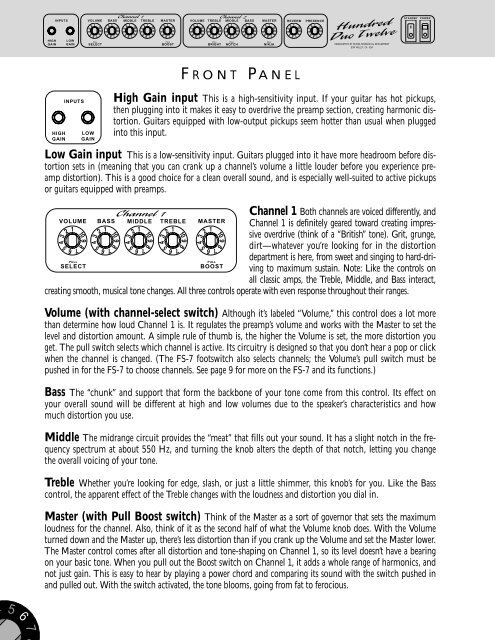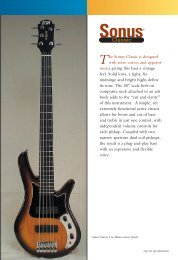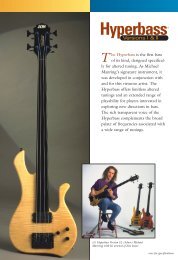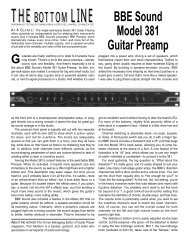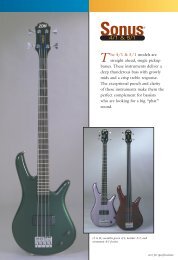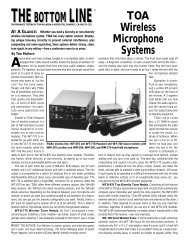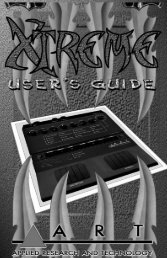You also want an ePaper? Increase the reach of your titles
YUMPU automatically turns print PDFs into web optimized ePapers that Google loves.
7<br />
8<br />
4<br />
4<br />
4<br />
4<br />
4<br />
4<br />
4<br />
4<br />
4<br />
4<br />
4<br />
4<br />
INPUTS<br />
HIGH LOW<br />
GAIN GAIN<br />
PULL<br />
SELECT<br />
Channel 1<br />
PULL<br />
BOOST<br />
Channel 2<br />
VOLUME BASS MIDDLE TREBLE MASTER VOLUME TREBLE MIDDLE BASS MASTER REVERB PRESENCE<br />
5<br />
2<br />
3<br />
6<br />
1<br />
7<br />
10 9<br />
8<br />
5<br />
2<br />
3<br />
6<br />
1<br />
7<br />
10 9<br />
8<br />
5<br />
2<br />
3<br />
6<br />
1<br />
7<br />
10 9<br />
8<br />
5<br />
2<br />
3<br />
6<br />
1<br />
7<br />
10 9<br />
8<br />
5<br />
2<br />
3<br />
6<br />
1<br />
7<br />
10 9<br />
8<br />
5<br />
2<br />
3<br />
6<br />
1<br />
7<br />
10 9<br />
8<br />
5<br />
2<br />
3<br />
6<br />
1<br />
7<br />
10 9<br />
8<br />
PULL<br />
BRIGHT<br />
5<br />
2<br />
3<br />
6<br />
1<br />
7<br />
PULL<br />
NOTCH<br />
10 9<br />
8<br />
5<br />
2<br />
3<br />
6<br />
1<br />
7<br />
10 9<br />
8<br />
5<br />
2<br />
3<br />
6<br />
1<br />
7<br />
PULL<br />
NINJA<br />
10 9<br />
8<br />
5<br />
2<br />
3<br />
6<br />
1<br />
7<br />
10 9<br />
8<br />
5<br />
2<br />
3<br />
6<br />
1<br />
7<br />
10 9<br />
8<br />
Hundred<br />
Duo Twelve<br />
HANDCRAFTED BY RIVERA RESEARCH & DEVELOPMENT<br />
SUN VALLEY, CA USA<br />
STANDBY<br />
POWER<br />
F RONT<br />
P ANEL<br />
HIGH<br />
GAIN<br />
INPUTS<br />
LOW<br />
GAIN<br />
High Gain input This is a high-sensitivity input. If your guitar has hot pickups,<br />
then plugging into it makes it easy to overdrive the preamp section, creating harmonic distortion.<br />
Guitars equipped with low-output pickups seem hotter than usual when plugged<br />
into this input.<br />
Low Gain input This is a low-sensitivity input. Guitars plugged into it have more headroom before distortion<br />
sets in (meaning that you can crank up a channel’s volume a little louder before you experience preamp<br />
distortion). This is a good choice for a clean overall sound, and is especially well-suited to active pickups<br />
or guitars equipped with preamps.<br />
4<br />
Channel 1<br />
VOLUME BASS MIDDLE TREBLE MASTER<br />
5<br />
2<br />
3<br />
6<br />
1<br />
7<br />
10 9<br />
8<br />
PULL<br />
SELECT<br />
4<br />
5<br />
2<br />
3<br />
6<br />
1<br />
7<br />
10 9<br />
8<br />
4<br />
5<br />
2<br />
3<br />
6<br />
1<br />
7<br />
10 9<br />
8<br />
4<br />
5<br />
2<br />
3<br />
6<br />
1<br />
7<br />
10 9<br />
8<br />
4<br />
5<br />
2<br />
3<br />
6<br />
1<br />
7<br />
10 9<br />
8<br />
PULL<br />
BOOST<br />
Channel 1 Both channels are voiced differently, and<br />
Channel 1 is definitely geared toward creating impressive<br />
overdrive (think of a “British” tone). Grit, grunge,<br />
dirt—whatever you’re looking for in the distortion<br />
department is here, from sweet and singing to hard-driving<br />
to maximum sustain. Note: Like the controls on<br />
all classic amps, the Treble, Middle, and Bass interact,<br />
creating smooth, musical tone changes. All three controls operate with even response throughout their ranges.<br />
Volume (with channel-select switch) Although it’s labeled “Volume,” this control does a lot more<br />
than determine how loud Channel 1 is. It regulates the preamp’s volume and works with the Master to set the<br />
level and distortion amount. A simple rule of thumb is, the higher the Volume is set, the more distortion you<br />
get. The pull switch selects which channel is active. Its circuitry is designed so that you don’t hear a pop or click<br />
when the channel is changed. (The FS-7 footswitch also selects channels; the Volume’s pull switch must be<br />
pushed in for the FS-7 to choose channels. See page 9 for more on the FS-7 and its functions.)<br />
Bass The “chunk” and support that form the backbone of your tone come from this control. Its effect on<br />
your overall sound will be different at high and low volumes due to the speaker’s characteristics and how<br />
much distortion you use.<br />
Middle The midrange circuit provides the “meat” that fills out your sound. It has a slight notch in the frequency<br />
spectrum at about 550 Hz, and turning the knob alters the depth of that notch, letting you change<br />
the overall voicing of your tone.<br />
Treble Whether you’re looking for edge, slash, or just a little shimmer, this knob’s for you. Like the Bass<br />
control, the apparent effect of the Treble changes with the loudness and distortion you dial in.<br />
Master (with Pull Boost switch) Think of the Master as a sort of governor that sets the maximum<br />
loudness for the channel. Also, think of it as the second half of what the Volume knob does. With the Volume<br />
turned down and the Master up, there’s less distortion than if you crank up the Volume and set the Master lower.<br />
The Master control comes after all distortion and tone-shaping on Channel 1, so its level doesn’t have a bearing<br />
on your basic tone. When you pull out the Boost switch on Channel 1, it adds a whole range of harmonics, and<br />
not just gain. This is easy to hear by playing a power chord and comparing its sound with the switch pushed in<br />
and pulled out. With the switch activated, the tone blooms, going from fat to ferocious.<br />
5<br />
6


